Today’s post is from Kelly Sherman-Conroy (Oglala Sioux), Luther Seminary student and member of the American Indian/Alaska Native Lutheran Association.

In August of 2016 the ELCA made a promise to the Native people. The Churchwide Assembly, made up of members of the ELCA, passed a resolution written by ELCA Native American clergy Bishop Guy Erwin (Osage Nation) and Pastor Joan Conroy (Oglala Sioux) to recognize and celebrate contributions of Native Americans in the life of the church and community.
The whole body of the ELCA confessed that they were wrong and repudiated, explicitly and clearly, the European-derived Doctrine of Discovery, a document that has been used to justify racism against and enslavement of indigenous peoples since it was written in 1493.
This papal bull, known in Latin as “Inter Caetera,” gave Christian explorers the right to claim lands they “discovered” for their Christian monarchs. Any land discovered that was not inhabited by Christians could be exploited. If pagan inhabitants could not be converted, they could be enslaved or killed. Indigenous people have felt the sting of that papal edict since Europeans first landed in North America. The Native culture, according to early missionaries, did not fit the Christian religion, and belief in the Gospel required them to give up who they were in order to become something they could never be… white.
When the ELCA passed the resolution formally repudiating the Doctrine of Discovery, one of the commitments that was made was to “encourage the Office of the Presiding Bishop to plan an appropriate national ceremony of repentance and reconciliation with tribal leaders, providing appropriate worship resources for similar synodical and congregational observances with local tribal leaders, at such times and places as are appropriate.”
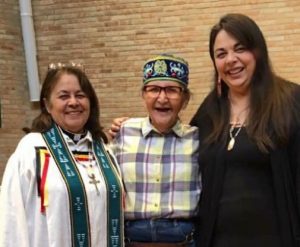 This Native American Liturgical Celebration and Service of Reconciliation was created by Kelly Sherman-Conroy, a member of the Oglala Sioux Tribe in Pine Ridge South Dakota, who attends Nativity Lutheran Church in St. Anthony, MN and also currently attends Luther Seminary. This liturgy, with the help of many people, was put together to in a meaningful way integrate Native culture and spirituality, and also keep some boundaries of the Lutheran Christian traditions. The result is that a profound and deeply spiritual experience has been created for all involved, not just in the worship practices themselves but in relationship with God and the other. In other words, inculturation (the adaptation of worship to various cultural settings) aims to deepen the spiritual life of the assembly through a fuller experience of Christ who is revealed in Native people’s language, rites, arts, and symbols.
This Native American Liturgical Celebration and Service of Reconciliation was created by Kelly Sherman-Conroy, a member of the Oglala Sioux Tribe in Pine Ridge South Dakota, who attends Nativity Lutheran Church in St. Anthony, MN and also currently attends Luther Seminary. This liturgy, with the help of many people, was put together to in a meaningful way integrate Native culture and spirituality, and also keep some boundaries of the Lutheran Christian traditions. The result is that a profound and deeply spiritual experience has been created for all involved, not just in the worship practices themselves but in relationship with God and the other. In other words, inculturation (the adaptation of worship to various cultural settings) aims to deepen the spiritual life of the assembly through a fuller experience of Christ who is revealed in Native people’s language, rites, arts, and symbols.
On November 22nd this service will be live streamed from Nativity Lutheran Church in its entirety. You will be able to join the live stream at Nativity’s web site, and more information about the event is available on Facebook. It is my hope that this service and celebration will serve as an example as to how this liturgy can be used in regions across the ELCA, and that the participants will have a blessed, faith-filled and formative experience.
If you would like to host this liturgy in your own synod or congregation, the worship resources themselves and a list of guidelines created to aid in the use of the liturgy may be found from ELCA.org. The American Indian/Alaska Native Lutheran Association is also available for conversation via email at ELCANATIVE@gmail.com.
Images:
Image 1 is a photo of Kelly Sherman-Conroy, taken at Luther Seminary during worship

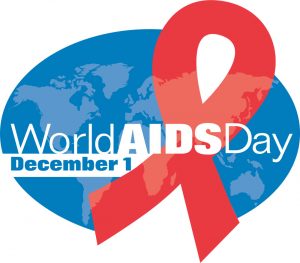

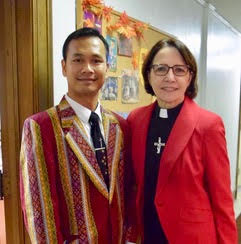 Last Sunday for the 500th anniversary of the Reformation, St. Stephen in Syracuse, NY worshipped with two other congregations; those who also worship in our building. Both are immigrant Christian congregations, not connected to the ELCA, except through us. The small Burundi church understands English and didn’t want anything translated. They were happy to be in among the assembly. However, the Evangelical Living Church (ELC), a Burmese Chin congregation, doesn’t understand English as well, so we used an outline (with some explanations) of our joint worship up on their screen with a PowerPoint in Chin. Detailed explanations were printed of what we’re doing and why in our English worship bulletin. We worked closely with the ELC, over three weeks, to pull our Reformation worship together in both languages. The Gospel was read in English by me and in Chin by Pastor Elisha Thwang. Pastor Elisha also offered a prayer in Chin after the Thanksgiving for the Word. In addition, the ELC choir, most of whom attend high school in the city, joined our own choir for the event. Our worship was filled with the grace-filled readings, prayers, and joyful music in English and Chin. We used the ELC’s version of an “Alleluia” for our Gospel Acclamation (to the tune of Amazing Grace: Alleluia, Alleluia, Alleluia Amen… Alleluia, Alleluia, Alleluia Amen), and the ELC Choir, along with Pastor Elisha offered an Anthem in Chin, the title, of which translated: Standing on the Promises.
Last Sunday for the 500th anniversary of the Reformation, St. Stephen in Syracuse, NY worshipped with two other congregations; those who also worship in our building. Both are immigrant Christian congregations, not connected to the ELCA, except through us. The small Burundi church understands English and didn’t want anything translated. They were happy to be in among the assembly. However, the Evangelical Living Church (ELC), a Burmese Chin congregation, doesn’t understand English as well, so we used an outline (with some explanations) of our joint worship up on their screen with a PowerPoint in Chin. Detailed explanations were printed of what we’re doing and why in our English worship bulletin. We worked closely with the ELC, over three weeks, to pull our Reformation worship together in both languages. The Gospel was read in English by me and in Chin by Pastor Elisha Thwang. Pastor Elisha also offered a prayer in Chin after the Thanksgiving for the Word. In addition, the ELC choir, most of whom attend high school in the city, joined our own choir for the event. Our worship was filled with the grace-filled readings, prayers, and joyful music in English and Chin. We used the ELC’s version of an “Alleluia” for our Gospel Acclamation (to the tune of Amazing Grace: Alleluia, Alleluia, Alleluia Amen… Alleluia, Alleluia, Alleluia Amen), and the ELC Choir, along with Pastor Elisha offered an Anthem in Chin, the title, of which translated: Standing on the Promises.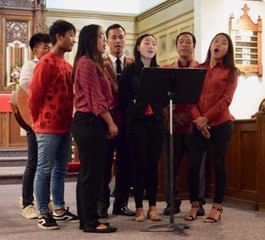 It was such an exciting day for us all – beyond my imagination for sure! We had been talking about having a joint worship for some time, and Reformation Sunday just seemed to be the perfect day to do it. It was a day to celebrate a church that is constantly reforming and always being made new. In doing so, we embraced our differences, while lifting up all the things we have in common. Last Sunday, nearly 500 years after Martin Luther offered up his 95 theses, St. Stephen sang A Mighty Fortress, together with folks from around the world, immigrants who came to the U.S. looking for a fortress of safety within our boundaries, sharing with us God’s own Mighty Fortress of grace and love for us all. We used a modified Service of the Word, and I inserted hymns where ever we could fit them. During the service, four of our youth affirmed their baptism in Confirmation, supported by every Christian present. It was truly a joy-filled and uplifting celebration for everyone.
It was such an exciting day for us all – beyond my imagination for sure! We had been talking about having a joint worship for some time, and Reformation Sunday just seemed to be the perfect day to do it. It was a day to celebrate a church that is constantly reforming and always being made new. In doing so, we embraced our differences, while lifting up all the things we have in common. Last Sunday, nearly 500 years after Martin Luther offered up his 95 theses, St. Stephen sang A Mighty Fortress, together with folks from around the world, immigrants who came to the U.S. looking for a fortress of safety within our boundaries, sharing with us God’s own Mighty Fortress of grace and love for us all. We used a modified Service of the Word, and I inserted hymns where ever we could fit them. During the service, four of our youth affirmed their baptism in Confirmation, supported by every Christian present. It was truly a joy-filled and uplifting celebration for everyone.
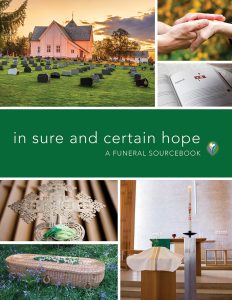
 For churches with questions about how to comply with copyright law, Augsburg Fortress has an archived webinar on copyright: Churches and Copyright: How to be a weekend publisher without going to prison. The webinar, presented by Augsburg Fortress’ Copyright Specialist Michael Moore (pictured), takes about an hour, and deals with copyrights, licenses, and the rights and responsibilities of churches when it comes to how to license content the church would like to use, but which is under copyright.
For churches with questions about how to comply with copyright law, Augsburg Fortress has an archived webinar on copyright: Churches and Copyright: How to be a weekend publisher without going to prison. The webinar, presented by Augsburg Fortress’ Copyright Specialist Michael Moore (pictured), takes about an hour, and deals with copyrights, licenses, and the rights and responsibilities of churches when it comes to how to license content the church would like to use, but which is under copyright.